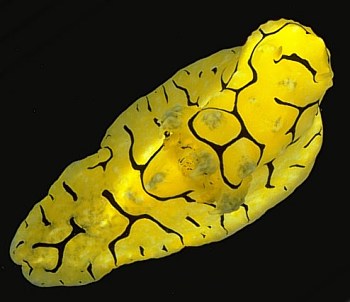
Notodoris minor
Eliot, 1904
Order: NUDIBRANCHIA
Suborder: DORIDINA
Superfamily: ANADORIDOIDEA
Family: Aegiretidae
DISTRIBUTION
Indo-West Pacific
PHOTO
Carters Reef, 24.5m, Lizard Is, Great Barrier Reef, North Queensland, Australia. November 1981. PHOTO: Bill Rudman.
As with other species of Notodoris, the skin is toughened with tiny spicules, the upper surface has a few irregular pustules, and the small rhinophores are smooth and simple. The branched gills are situated midway along the body, partially hidden by three large lobes. The animal has a yellow background colour, with a pattern of diagonal and transverse black lines arranged in a network over the entire body. The gills and rhinophores are essentially yellow, but in juveniles, and some adults, there can be some black pigmentation. Notodoris minor can grow to 14 cm in length.
N. minor feeds on calcareous sponges belonging to the family Leucettidae. On the Great Barrier Reef it has been found feeding on the calcareous sponge Pericharax heterographis and Gosliner et al. (1996) have recorded it eating Leucetta primigenia elsewhere in the Indo-West Pacific. It is often found on coral substrates, but its distribution is dependent on the presence of its food sponges. It has been found from 3 to 24 m in depth.
References:
• Eliot, C.N.E. (1904). On some nudibranchs from East Africa and Zanzibar. Part V. Proceedings of the Zoological Society of London, 1904(2): 83-105, Pls. 3-4.
• Gosliner, T.M. Behrens, D.W. & Williams, G.C. (1996). Coral reef animals of the Indo-Pacific. Sea Challengers, Monterey, California. 314 pp.
• Marshall, J.G. & Willan, R.C. (1999). Nudibranchs of Heron Island, Great Barrier Reef. A survey of the Opisthobranchia (Sea Slugs) of Heron and Wistari Reefs. Backhuys Publishers, Leiden, The Netherlands, 257 pp.
Rudman, W.B., 2003 (July 11) Notodoris minor Eliot, 1904. [In] Sea Slug Forum. Australian Museum, Sydney. Available from http://www.seaslugforum.net/find/notomino
Related messages
Notodoris minor from Solomon Ids
June 10, 2003
From: Bruce Potter
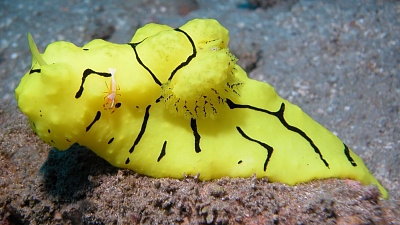
Dear Bill,
I am sending this photo of Notodoris minor for two reasons. It shows the gills better than in any other of my photos, and secondly, I did not even see the shrimp at the time I took the photo, but only saw it when I got it up on my computer.
I found it yesterday on a coral and rubble site on the outskirts of Honiara. it was about 70mm long and at 16m depth.
Regards
Bruce Potter.
bruce.potter@adventist.org.sb
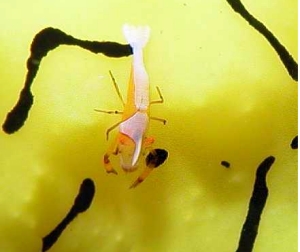
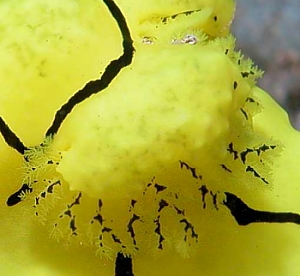
Thanks Bruce,
Your photo shows the gills extremely well, you don't often see a specimen showing black markings on the gills like this. We used to think the shrimp Periclimenes imperator was an obligate commensal on the Spanish Dancer Hexabranchus but it seems to be happy on any large opisthobranch.
best wishes,
Bill Rudman
Notodoris minor from Mauritius
November 20, 2002
From: Marina Poddubetskaia
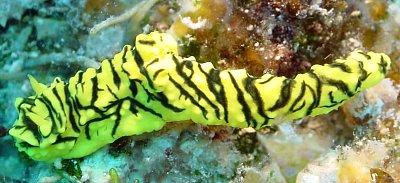
Dear Bill,
Here are some photos of Notodoris minor. Last year I saw this strange dorid only in Reunion and this year it was present only in Mauritius.
Upper Right: Pereybere, Mauritius, Indian Ocean. Site: L’aquarium de Merville. Depth: 10m. Size: 40-45mm. October 15, 2002
Lower Left: Pereybere, Mauritius, Indian Ocean. Site: Malen. Depth: 18m. Size: 30-35mm. October 18, 2002
Lower Right: Pereybere, Mauritius, Indian Ocean. Site: Grand Aquarium. Depth: 11m. Size: 40-45mm. October 17, 2002.
Photos: Marina Poddubetskaia - Nembro website
Best wishes,
Marina.
nembro@nembro.info
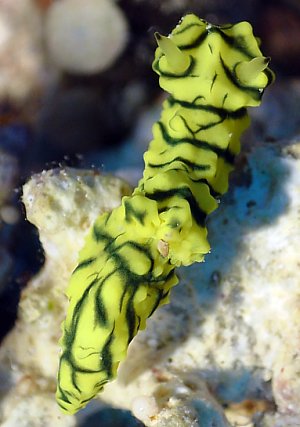
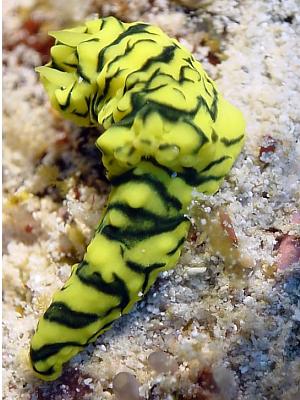
Dear Marina,
Thanks for these photos of juveniles. Of particular interest are the black tips to the rhinophores in the smallest animal (lower left). I have seen small Notodoris about 5mm long on the same sponge as adults and they have had black rhinophores, which raises the question as to whether they are juveniles or whetjer there is a small species with black rhinophores. I think your photo is pretty good evidence to show that black rhinophores are a juvenile character. I will have to find my photos.
Best wishes,
Bill Rudman
Notodoris minor from Tufi, Papua New Guinea
October 2, 2001
From: Des Paroz
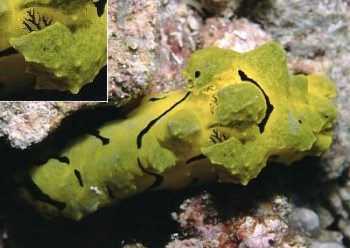
Dear Bill
Attached are 3 photos of 2 different specimens of Notodoris minor I photographed recently on Stewarts Reef, offshore of Tufi, Papua New Guinea. Depth was about 26m, and water temp 28C. N. minor was quite abundant at this reef, and also at the nearby, aptly named, Minor Reef.
Gills are showing quite clearly in the Upper right photo.
Des
des@paroz.com
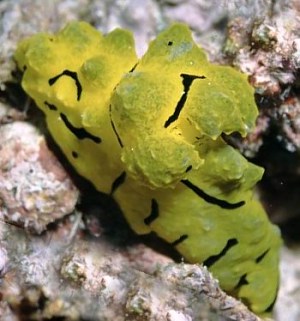
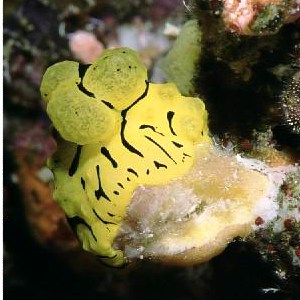
Thanks Des,
I see in the Lower Right photo that the Notodoris has almost completely eaten the colony of calcareous sponge it is sitting on, and is almost surrounded by piles of discarded sponge spicules.
Cheers,
Bill Rudman
Notodoris minor from Great Barrier Reef
September 25, 2001
From: John Fergusson
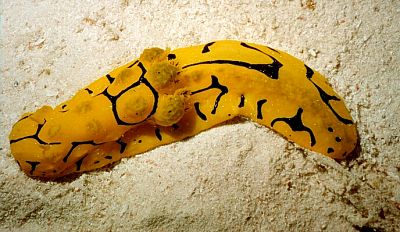
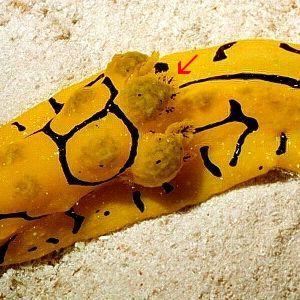
Dear Bill,
I took this photo on Wheeler Reef off Townsville in North Queensland on the
8th of September 2001. The depth was about 18-20M. He was moving across the sand in an open area between the bommies. He was approximately 12cm long and 4cm wide.
Do you have any idea what type of nudibranch it is?
John
(Townsville, QLD)
jfergusson@ozemail.com.au
Fergusson, J., 2001 (Sep 25) Notodoris minor from Great Barrier Reef. [Message in] Sea Slug Forum. Australian Museum, Sydney. Available from http://www.seaslugforum.net/find/5327Dear John,
This is Notodoris minor, a dorid nudibranch which is very well camouflaged to look like the sponge it feeds on, although when it is crawling over sand like this it tends to give the game away a bit. As part of the camouflage, the feathery gills, which are usually so obvious in dorid nudibranchs, are hidden beneath three warty sructures, which look like little sponge growths. I have added a red arrow in the lower photo to show the edges of the gills just peeking out beneath these structures. If you scroll down the page anf look at the messages below yours, you will find out more about the biology of this species.
Best wishes,
Bill Rudman
Finding mates
February 14, 2001
From: Mary Jane Adams
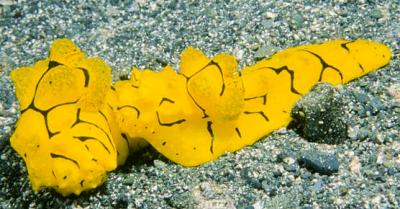
Hi Bill,
I have always wondered how sea slugs find each other in the vast space of the ocean. I once observed two Notodoris minor making a connection, but haven't a clue how it happened. I was swimming over a sand slope in Milne Bay, Papua New Guinea when I saw these two slugs crawling along at about 5 meters. The one on the left was creeping along in typical sluglike fashion, but the one on the right was streaking directly toward it from the side. This normally torpid slug covered more than two meters in just a few minutes. I took this shot just as they made contact. Unfortunately, I was low on air and could not stay around to see what happened next, but I have a good imagination. Luadi, PNG, September, 1994.
Best regards,
Mary Jane
divepng@yahoo.com
Adams, M.J., 2001 (Feb 14) Finding mates. [Message in] Sea Slug Forum. Australian Museum, Sydney. Available from http://www.seaslugforum.net/find/3710Dear Mary Jane,
I couldn't resist posting this one on Valentine's Day. With the recent announcement from the Human Genome Team that our genetic makeup is not much advanced on a worm's, it makes you wonder whether mate selection for humans is much more advanced than for slugs. Certainly for slugs, we can be pretty sure that love is blind, which is exactly what the poets say about humans ..... perhaps I should stop this train of thought before I get into trouble.
Best wishes,
Bill Rudman
Notodoris minor - feeding observations
January 2, 2001
From: Mary Jane Adams
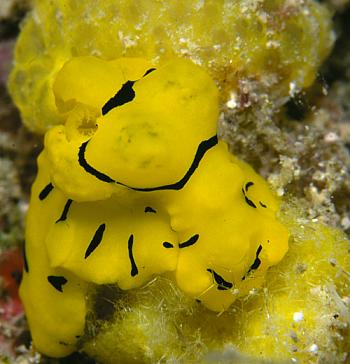
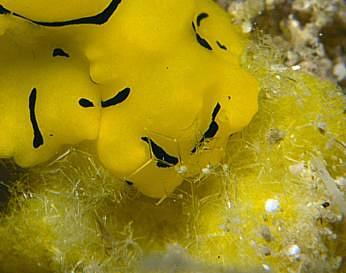
Happy New Year, Bill
Here is a picture of Notodoris minor eating its way through a sponge. I shot this in November, 2000 at Karumolun Island in the Russell Group of the Solomon Islands. It shows skeletal remains of the sponge where the slug has consumed the soft tissue. It does appear that it has somehow sucked the tissue from around the skeleton. It may be that N. minor eats some of the smaller spicules while leaving behind the larger ones. This appears to be a different sponge than the ones I have seen N. minor eating in Milne Bay, PNG. [see my earlier message]
Depth: 6 meters
Length: about 3 cm
Water temp: 84 F
Best regards,
Mary Jane
divepng@yahoo.com
Adams, M.J., 2001 (Jan 2) Notodoris minor - feeding observations. [Message in] Sea Slug Forum. Australian Museum, Sydney. Available from http://www.seaslugforum.net/find/3457Dear Mary Jane,
Thanks for the photo. I have included a larger view to show the spicules more clearly. I also have the feeling that Notodoris dissolves the tissue from around the spicules before it swallows the 'mush' but we really need some direct evidence.
As to the identity of the sponge. I am not a sponge expert but I tend to think this is the same sponge, Pericharax heteroraphis, as in your earlier photo. Sponges are notoriously difficult to identify alive as they can vary greatly in shape and colour even in different part of the same colony. If you look carefully at your earlier photo the spicules seem to be of identical shape.
Best wishes,
Bill Rudman.
Notodoris minor from the Solomon Ids
December 31, 2000
From: Bruce Potter
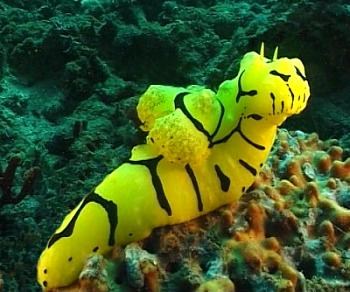
Dear Bill,
I frequently find examples of the very colourful, large Nudibranch Notodoris minor. While being very pretty, it is usually not very active. So when I found this particular one at the dive site, Bonegi 1, just outside of Honiara in the Solomon Islands, sitting up in such an artistic pose, I couldn't resist filming it. As I moved around it with my video lights on, it's head followed the movement of the lights closely. It is certainly the most active N. minor I have yet encountered.
Regards
Bruce Potter.
bruce.potter@adventist.org.sb
Potter, B., 2000 (Dec 31) Notodoris minor from the Solomon Ids. [Message in] Sea Slug Forum. Australian Museum, Sydney. Available from http://www.seaslugforum.net/find/3391Dear Bruce,
Thanks for the photo. Yes I must say that I would rank species of Notodoris with the Koala in the slowest mover's list. Koalas are supposed to be so listless because they are full of nasty chemicals from the Eucalyptus leaves they eat but I don't know what Notodoris's excuse is. Perhaps they just want to look very much like a piece of sponge.
One thing which would be worth looking out for, if they are common, is how they eat their sponge. Often they are found with a large pile of cleaned sponge spicules alongside their feeding site. It almost looks like they are dissolving the sponge tissue away from the spicules before feeding on the resulting soup. If so, this would be an interesting discovery. The alternative is that the spicules are eaten in conjunction with the sponge tissue and then passed out in the faeces, but the way the spicules are usually piled up suggests this is not the case. So if you feel the need to rest on the way up after a dive, a study of Notodoris feeding would be an good excuse.
Best wishes,
Bill Rudman
Notodoris minor from the Solomons Ids
October 16, 2000
From: Bruce Potter
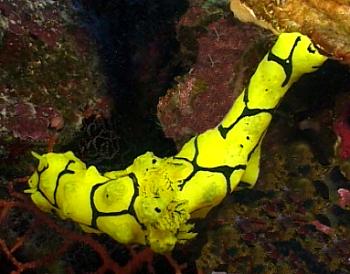
Here is a photo of Notodoris minor from a recent trip to Russell Islands in the Solomons. It was 20 meters down a vertical wall near Leru Cut dive site.
Bruce Potter
bruce.potter@adventist.org.sb
Potter, B., 2000 (Oct 16) Notodoris minor from the Solomons Ids. [Message in] Sea Slug Forum. Australian Museum, Sydney. Available from http://www.seaslugforum.net/find/3183Thanks Bruce,
Bill Rudman.
Notodoris minor from Papua New Guinea
October 9, 2000
From: Stuart Hutchison
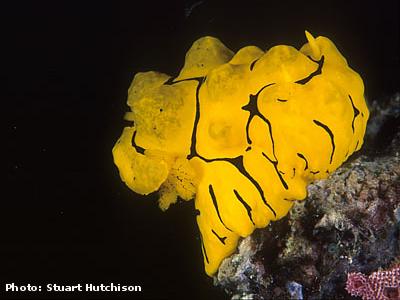
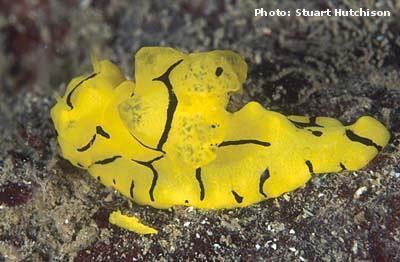
Hi Bill,
Here are a couple of shots of Notodoris minor from Milne Bay, Papua New Guinea. The first was taken in six meters at Ipoteto Island and the other pair were in four meters at Deacon's Reef. The larger animals were about three inches long. The smaller specimen just happened to be right alongside it's bigger brother. The photos were taken in March 1999.
Stuart Hutchison
hutchco@tpg.com.au
Hutchison, S., 2000 (Oct 9) Notodoris minor from Papua New Guinea. [Message in] Sea Slug Forum. Australian Museum, Sydney. Available from http://www.seaslugforum.net/find/3138Dear Stuart,
Thanks for the photos,
Bill Rudman.
Notodoris minor - mating & egg-laying
February 6, 2000
From: Mary Jane Adams
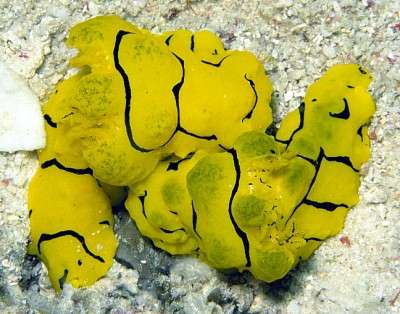
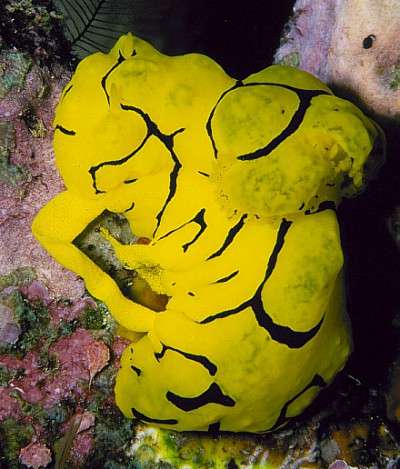
Dear Bill,
Here are some images for your Notodoris minor page.
UPPER: Mating pair in a rubble patch on a coral reef, Milne Bay, Papua New Guinea. Divesite: "Black and Silver", depth 10 meters. Nov. 21, 1995
LOWER: Egg laying at 10 meters. "Peer's Reef", Milne Bay, Papua New Guinea, March 23, 1998. All the N. minor I have seen are exactly the shade of yellow and their eggs are an exact match.
Best regards,
Mary Jane Adams
mjadams@earthlink.net
Dear Mary Jane,
Thanks for these great photos. I have posted the feeding photo you also sent, as a separate message.
For those of you not familiar with nudibranch anatomy, they are hermaphrodites with both male and female equipment. The common genital opening is on the right anterior side of the body. When mating, or preparing to mate, the two partners have their right sides together, which they are doing in the upper photo.
These photos also show the very characteristic shield or flap of tough skin which arches over the gills protecting them from view, presumably reinforcing the sponge-like look of the animal and hising the gills from potential predators.
Bill Rudman.
Rudman, W.B., 2000 (Feb 6). Comment on Notodoris minor - mating & egg-laying by Mary Jane Adams. [Message in] Sea Slug Forum. Australian Museum, Sydney. Available from http://www.seaslugforum.net/find/1848Notodoris minor - feeding behaviour
February 6, 2000
From: Mary Jane Adams
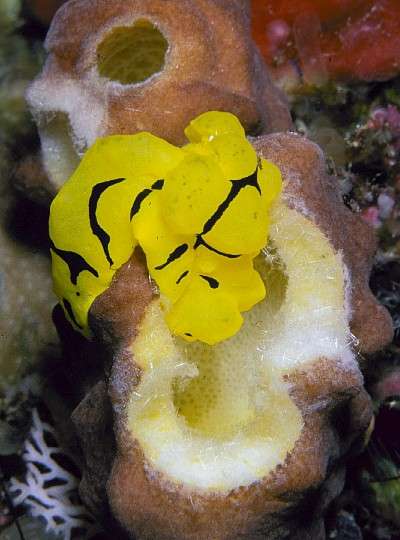
Dear Bill,
Here is a photo Notodoris minor feeding.
This is the sponge I have most often seen N. minor eating. It has left behind the spicules, including a pile at the bottom of the photo.
Divesite: "Double Tower", a coral reef near Sanaroa Island, Papua New Guinea, May 19, 1998.
Best regards,
Mary Jane Adams
mjadams@earthlink.net
Dear Mary Jane,
I am pretty sure this is the calcareous sponge Pericharax heteroraphis which is the only sponge I have records of N. minor and N. gardineri feeding on.
The pile of spicules alongside the feeding animal is also quite characteristic. These spicules are part of the skeletal framework which hold the sponge together. What we don't know is how it separates out the spicules while it is eating. Most sponge-feeders eat their sponge in chunks spicules and all, sorting out the spicules in their stomach and passing them in their faeces. This doesn't seem to be the case here. There seem to be three possibilities.
• 1. The nudibranch spits the spicules out as its feeding (like I eat bony fish).
• 2. It somehow predigests the sponge, perhaps with salivary juices, and sucks up the digested tissue leaving the spicules behind.
• 3. It eats all the sponge and somehow passes the spicules through its digestive system. (not very likely as the spicules are clean and separate).
If anyone wants to stop and watch Notodoris feeding for an hour or so, it would be interesting to know how these piles of clean spicules are formed.
Finally about the identity of Notodoris's food. I read today in Gosliner, T.M., Behrens, D.W. & Williams, G.C. (1996) [Coral Reef Animals of the Indo Pacific: Sea Challengers, Monterey, 314pp] that they state that N. minor & N. gardineri feed on the calcareous sponge Leucetta primigenia, which is red in colour with a white band bordering the the openings of its flask-like structure. I have no record, or have seen no photo, of these species on anything but the brownish sponge you illustrate above and I have had identified as Pericharax. Perhaps they feed on both sponges.
As I state elsewhere, N. citrina feeds on a bright yellow species of Leucetta.
Bill Rudman.
Rudman, W.B., 2000 (Feb 6). Comment on Notodoris minor - feeding behaviour by Mary Jane Adams. [Message in] Sea Slug Forum. Australian Museum, Sydney. Available from http://www.seaslugforum.net/find/1858Notodoris minor from Mauritius
February 4, 2000
From: Owen Griffiths
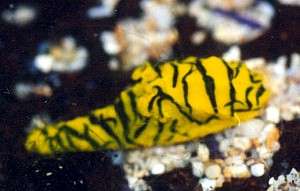
Dear Bill,
Can you identify this nudibranch from Mauritius please?
Riambel, Mauritius, in coral Lagoon, September 1999. Approximately 25mm long.
Owen Griffiths.
Mauritius.
Olgmas@bow.intnet.mu
Griffiths, O.L., 2000 (Feb 4) Notodoris minor from Mauritius. [Message in] Sea Slug Forum. Australian Museum, Sydney. Available from http://www.seaslugforum.net/find/1820Dear Owen,
This is Notodoris minor. Have a look at the top of this page for some information on this species, and at the messages below yours for other pictures.
Bill Rudman.
Notodoris minor from Philippines
September 15, 1999
From: Erwin Koehler
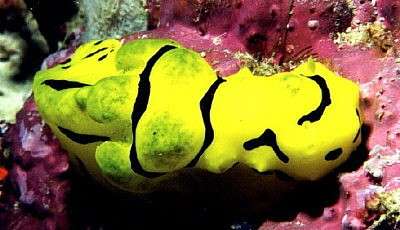
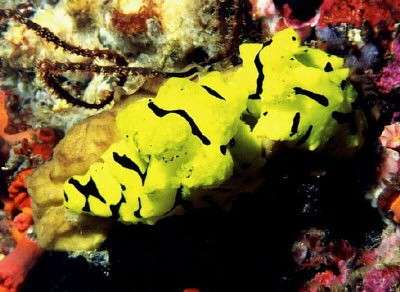
Bill,
here are two photos of Notodoris minor Eliot, 1904 from the Philippines
UPPER: size 6cm, depth 18m, October 31, 1998, Balicasag Is.
LOWER:(two specimens feeding on a yellow sponge):size ~6 cm, depth 19m, November 18, 1998, Panglao Is., divesite "Doljo"
Erwin.
Medslugs.Koehler@t-online.de
Koehler, E., 1999 (Sep 15) Notodoris minor from Philippines. [Message in] Sea Slug Forum. Australian Museum, Sydney. Available from http://www.seaslugforum.net/find/1332Thanks Erwin,
It's surprising how many well-known species I still have to put on the Forum.
Bill Rudman.
